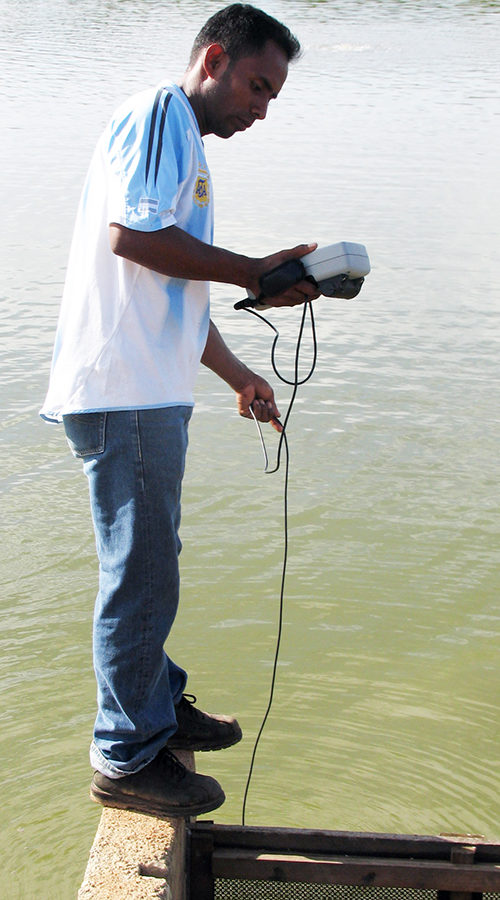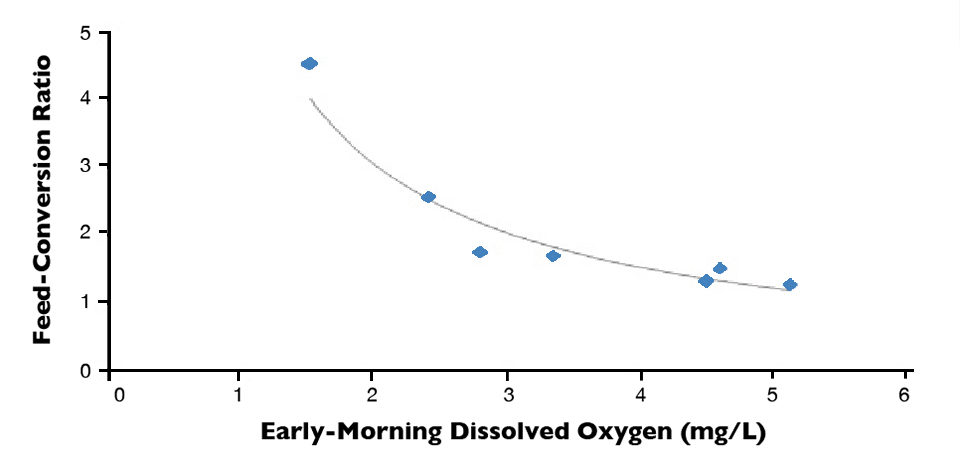Accepted minimum DO criteria for warmwater species not yet developed

Low dissolved oxygen concentration is recognized as a major cause of stress, poor appetite, slow growth, disease susceptibility and mortality in aquaculture animals. It is generally accepted that the minimum daily dissolved oxygen concentration in pond culture systems is of greatest concern.
Dissolved-oxygen levels can be high during most of a 24-hour period, but the response of culture species appears to be
affected primarily by the lowest dissolved oxygen concentration during the night. Nevertheless, accepted minimum dissolved-oxygen criteria for warmwater aquaculture species have not been developed.
Considerable data are available on the effects of dissolved-oxygen concentration on warmwater culture species, especially channel catfish, penaeid shrimp and tilapia. For example, a literature review conducted by scientists of the United States Environmental Protection Agency considered the growth of fish at different minimum daily dissolved oxygen concentrations.
The review indicated that at concentrations below 50 percent of saturation, growth rates declined and became progressively less as the minimum dissolved-oxygen concentrations decreased. At a water temperature of 26 degrees-C, freshwater at 50 percent oxygen saturation contains about 4 mg/L of dissolved oxygen. This concentration is probably higher than realistically can be maintained in the early morning in most warmwater aquaculture ponds.
Studies
Catfish
A study conducted by researchers at the University of Georgia revealed that channel catfish held at 36 and 60 percent of dissolved oxygen saturation ate and grew less than catfish held at 100 percent of saturation. In one trial, fish held at 60 percent saturation converted feed to biomass more effectively than fish held at 36 percent saturation, but there was no difference in feed-conversion ratios from 36 and 60 percent saturation treatments in another trial. At 26 degrees-C in freshwater, 36 and 60 percent saturation equate to dissolved oxygen concentrations of 2.91 and 4.85 mg/L, respectively.
Studies at Auburn University with channel catfish showed that survival, production and feed-conversion ratios (FCRs) were better in ponds where average minimum daily oxygen concentrations did not fall below 3.5 mg/L. Feed conversion was particularly influenced by early morning dissolved oxygen concentrations (Fig. 1). Fish were fed according to a feeding table without adjustment for poor appetite or mortality.
The lower FCR in response to greater morning dissolved-oxygen concentration in these trials resulted partially from overfeeding in the ponds, where lower dissolved oxygen concentrations led to less feed intake and greater mortality. Oftentimes, moderate mortality of cultured animals in pond systems goes undetected, and feed is applied as if the mortality had not occurred. The relationship underscores the importance of adjusting feeding rates for fish appetite and mortality. When the extent of mortality is unknown, care should be exercised to avoid feeding more than fish will eat.
Work done by a U.S. Department of Agriculture scientist in Mississippi revealed that FCR was not affected by minimum daily dissolved oxygen concentrations as low as 2 mg/L. However, fish ate more and grew better in ponds where dissolved oxygen levels did not fall below 3 mg/L.

Shrimp
In a shrimp-feeding experiment conducted at the Claude Peteet Mariculture Center in Alabama, USA, shrimp were stocked at 33 postlarvae per square meter, and triplicate ponds were aerated at three rates to provide different morning dissolved oxygen levels (Table 1). Survival, production and FCR improved in response to higher minimum dissolved oxygen concentrations.
Boyd, Effects of minimum daily dissolved-oxygen, Table 1
| Average Minimum Dissolved-Oxygen Concentration (mg/L) | Survival (%) | Production (kg/ha) | Feed-Conversion Ratio |
|---|---|---|---|
| 2.32 | 42 | 2,976 | 2.64 |
| 2.96 | 55 | 3,631 | 2.21 |
| 3.89 | 61 | 3,975 | 1.96 |
However, as in the catfish experiments at Auburn University, shrimp in ponds with lower morning oxygen concentrations may have been overfed because of unseen and unknown higher mortality in the ponds. This event alone might have caused greater FCRs in the ponds with lower dissolved oxygen concentrations.
Tilapia
A feeding experiment was conducted with tilapia in ponds in Honduras with three treatments: no mechanical aeration, the control; aerators turned on when dissolved oxygen concentrations fell to 10 percent of saturation; and aerators turned on when dissolved oxygen dropped to 30 percent of saturation.
There was not a clear difference in survival among treatments, but fish were larger and production was higher in aeration treatments than in the control (Table 2). Fish size and production were similar in the two aeration treatments. Feed conversion was not reported.
Boyd, Effects of dissolved-oxygen saturation, Table 2
| Treatment | Survival (%) | Average Size (g) | Production (kg/ha) |
|---|---|---|---|
| No aeration | 87 | 194 | 3,404 |
| 10% saturation | 80 | 229 | 4,133 |
| 20% saturation | 91 | 235 | 4,269 |
Aeration
Aerated channel catfish and shrimp ponds often have minimum daily dissolved oxygen concentrations below 3 mg/L, and many times concentrations are below 2 mg/L. The application of more aeration to increase oxygen concentration should improve survival, feed consumption and production, and might improve FCR.
Preliminary economic analyses show additional costs for electricity and fixed aerator costs would be more than offset by additional fish weight and revenue produced. Tilapia ponds often are not aerated, but aeration should be beneficial in ponds where dissolved oxygen concentrations often fall below 1 mg/L.
(Editor’s Note: This article was originally published in the January/February 2010 print edition of the Global Aquaculture Advocate.)
Authors
-

Claude E. Boyd, Ph.D.
Department of Fisheries and Allied Aquacultures
Auburn University
Alabama 36849 USA[117,100,101,46,110,114,117,98,117,97,64,49,101,99,100,121,111,98]
-

Terry Hanson, Ph.D.
Auburn University
Alabama 36849 USA
Tagged With
Related Posts

Aquafeeds
A look at corn distillers dried grains with solubles
Corn distillers dried grains with solubles are an economical source of energy, protein and digestible phosphorus to reduce feed costs and fishmeal usage.

Responsibility
A look at unit processes in RAS systems
The ability to maintain adequate oxygen levels can be a limiting factor in carrying capacities for RAS. The amount of oxygen required is largely dictated by the feed rate and length of time waste solids remain within the systems.

Responsibility
Advances in super-intensive, zero-exchange shrimp raceways
Research at the Texas AgriLife Research Mariculture Laboratory is investigating ways to improve the economic viability of super-intensive raceways for shrimp production.

Responsibility
Accuracy of custom water analyses varies
The reliability of trace element analyses reported by custom laboratories cannot be checked by simple techniques, and results may not always be accurate. One should check the reliability of major ion analyses by determining the charge balance and comparing the measured total ion concentration with the total ion concentration estimated from conductivity.

